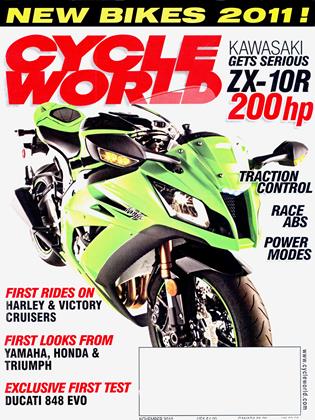Candid Cameron
My question is in regard to oil. I recently purchased a new BMW F800GS, and one of that bike’s upsides for me was being able to change the oil easily (spin-on filter that is accessible). My dealer says that I need to use a 10W-40 “motorcycle grade” oil. Why is this necessary? I have always used the “Made for high-revving engines” brand in my smaller-displacement cars. If that oil is SE (gasoline) rated, why is it necessary to have a motorcycle grade? And when is a 10W-40 oil not a 10W-40 oil?
Brian Eddy Columbus, Ohio
A What they mean by a motorcyclegrade oil is one that contains useful amounts of the anti-wear additive ZDDP (zinc dialkyl dithio phosphate). Automotive oils of recent API categories have had their ZDDP content reduced because the zinc could, especially in older engines with failing piston rings, reach the catalytic con-
verter and destroy its function. In place of that anti-wear additive, automotive oils now contain “friction modifiers,” which used to be called oiliness additives. These employ fatty acids to form a surface layer on parts (I think of it as “grass,” because one end of the additive chain bonds to the surface) that has a friction-reducing effect. Such additives have been implicated in starter-clutch slippage in motorcycle engines, along with a few other issues.
It’s true that many bikes now have catalytic converters, but the low-zinc formulation is based on the idea that cars are more likely to wear out in service. In most states, cars are regularly smog-checked, and their emissions equipment, by law, must remain functional for 100,000 miles. Motorcycles are not smog-checked or subject to those same mileage regulations, so the use of ZDDP in their oils is not problematic. In the end, the decision is up to the user.
Kevin Cameron
 View Full Issue
View Full Issue
More From This Issue
-
 Up Front
Up FrontMotor. Cycle.
November 2010 By Mark Hoyer -
 Roundup
RoundupBuell Fights Back
November 2010 By Steve Anderson -
 Roundup
RoundupItalian Triple Threat
November 2010 By Jeff Robert -
 Roundup
RoundupUps & Downs
November 2010 -
 Roundup
RoundupTeam Cycle World
November 2010 By Paul Dean -
 Roundup
RoundupHeadbanger
November 2010 By Bruno Deprato




